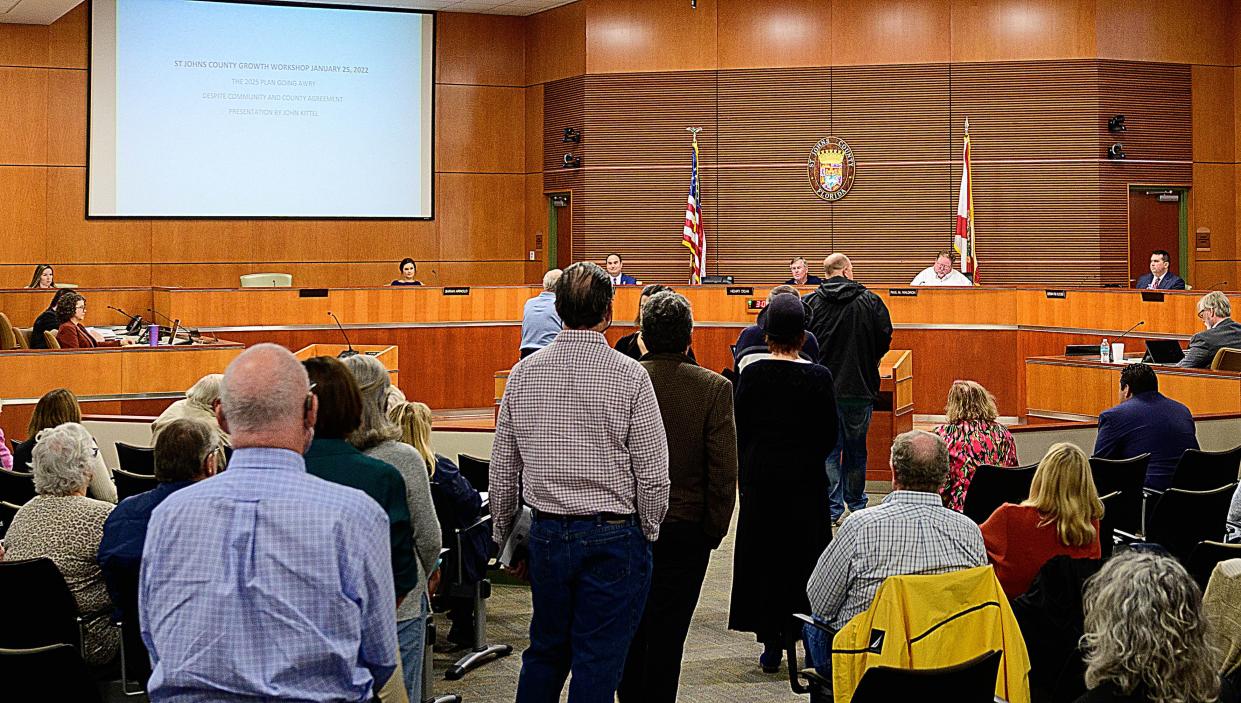Is St. Johns County being overdeveloped? Some residents say yes

If there was any doubt about what a hot-button issue development is in St. Johns County, the droves of citizens who spoke at Tuesday's growth management workshop made that answer clear.
The open forum sponsored by the Board of County Commissioners drew a crowd that nearly filled the municipal administrative complex auditorium. One after the next, for almost three hours, speakers talked about traffic, schools, the environment, infrastructure, housing prices and other impacts they say are changing the community's character.
Their message to commissioners was essentially the same: Stop the explosive growth St. Johns County has undergone in recent years.
Development: St. Augustine nonprofit wants $100 million performing arts center on city-owned land
More growth: St. Johns County Commission approves SilverLeaf expansion
Ponce de Leon Mall: Anchor Faith Church buys mall property for $10.7M, plans to increase community engagement
According to the latest census report, between 2010 and 2020, St. Johns County's population grew by nearly 44%, from 190,039 to 273,425. It is the second-fastest growing county in Florida, with many more residential and commercial projects still in the works, especially in the northern sector.
In an overview before the public comment period, county officials shared data showing that of 137,153 planned units of development currently approved for residential use, 75,480 had yet to be built. That means a lot more construction on the horizon for county residents to deal with.
A full one-third of county land must remain undeveloped under conservation easements or other federal or regional land use protections.
Still, with all the ongoing development comes challenges to ensuring services and infrastructure keep pace in areas like law enforcement, fire protection, roads and parks.

Commissioners said they wanted to have the meeting so they could hear from residents directly about their concerns, while still considering how to strike a balance between those issues and private property rights.
Several residents told board members they were either confused by impact (otherwise known as "concurrency") fees developers pay to offset some of the burden new residents might place on municipal services, or they thought the compensation system should be revamped.
Currently, development applicants are frozen at the impact fees assigned them at the time of their application, which factor in residential density and other variables. But it doesn't take into consideration inflation if a developer waits, say, 15 years to break ground on a project.
Commissioner Paul Waldron said he, for one, thought that inflation should be taken into account so the county didn't lose out on this revenue.
One idea floated by Phong Nguyen, director of transportation development for the county, was officials consider the alternative of mobility fees instead of impact fees, as some other high-growth areas of the country have done. Mobility fees allow developers to contribute more resources to other modes of transportation, such as mass transit or walkability, than more vehicles on the road.
Many speakers focused on how traffic, from the southern to the northern ends of the county, was becoming unmanageable.
Patricia Simmons, who lives in the southern part of St. Johns County, said, "The roads are gonna be so clogged that we won't be able to get of our own neighborhoods."
County officials spoke about some road projects currently under construction, like the First Coast Expressway which will span Duval, Clay, and St. Johns counties, that could help curb local congestion.
Other road improvements meant to better connect areas of the county and relieve some overcrowding include an extension of County Road 2209 near the Silverleaf development and an extension of State Road 312 to State Road 16.
But these projects all cost money, something Nguyen pointed out. He said the county had just about $50 million to address existing deficiencies like these in the roadway system, never mind an additional $100 million contemplated by more development.
Some of those projects, Nguyen did note, could qualify for funding through the state Department of Transportation or the North Florida Transportation Organization.
Nocatee resident Anna Logan said she moved here to enjoy all the wildlife in the area and now just sees fish kills in local waterbodies, animals pushed out of their natural ecosystems by development, and other negative environmental impacts.
Logan added that she thought county officials must take look at development not on a case-by-case basis but in the larger context of projects underway or slated for future development.
Glen Landers, a retired civil engineer from Ponte Vedra Beach, said he was especially worried about the impact sea level rise, particularly coastal erosion, and climate change could have on new development going forward.
Justin Palesotti, president of the St. Johns Middle School Athletic Association, addressed county officials to let them know that they already face tough choices each season in how many student athletes they can accept into their organization.
"I worry about the other ones, where they'll go," Palesotti said, adding that he saw the problem of capacity for sports and athletic facilities just becoming worse as growth continues.
Commissioners contributed a few comments at the end of the workshop.
Jeremiah Blocker said he was in favor of considering a mobility fee versus an impact fee with more study on the topic. Blocker added that for a growing county of this size, perhaps St. Johns might consider another form of government "to better handle growth needs."
Blocker did not specify what kind of governing structure that might be.
County Commission Chair Henry Dean suggested a follow-up growth management meeting take place about six months from now, at which time more specifics could be considered, for example, whether a county sales tax should be implemented to cover mounting development costs.
This article originally appeared on St. Augustine Record: St. Johns County residents share concerns at growth workshop

